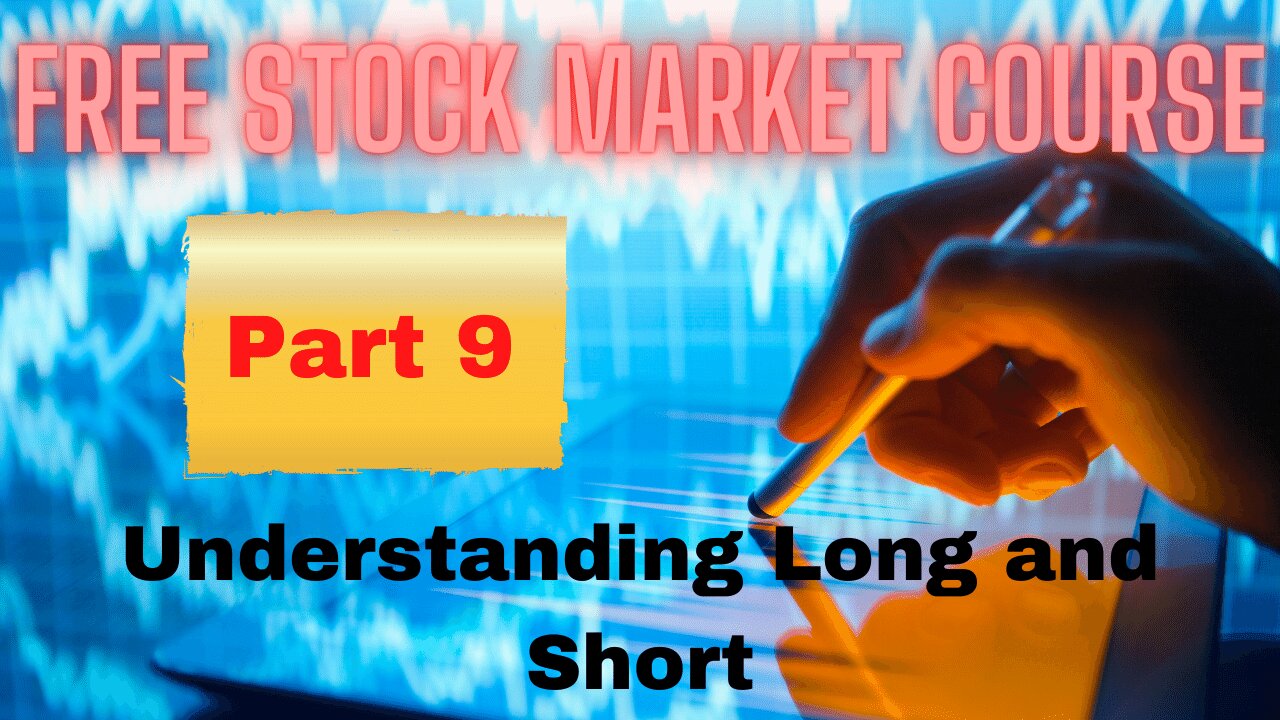Premium Only Content

Free Stock Market Course. Part 9 Understanding Long and Short
Free File downloads
Course notes, Audio files, Assessments, Transcript files, and Course Outline: https://spxinvestingblog.com/downloads/
My Exclusive Free Workshop: The Four P's of Building a Successful Investing Program → https://spxinvesting.mailchimpsites.com
Blog: https://spxinvestingblog.com
Facebook Group: https://www.facebook.com/groups/433843641082343
Chapters:
00:00 Understanding Long and Short
02:06 Long
03:36 Short
05:10 Verbal Example
07:35 Verbal Example with Text
09:43 Verbal Example with Graphics
13:51 Short Seller Be Ware!
16:38 Short Seller Haters
19:36 Understanding Short Selling
21:03 Inverse Positions
23:27 Short Interest
26:19 Unrealized Profits or Losses
27:45 Holding Period
Module 3 Section 1
Understanding Long and Short
There are two types of transactions in the stock market:
Buy
Sell
Long
Short
Long is pretty understandable.
Short Selling can be confusing and may require an “Aha Moment”.
Goal: You want to make some money.
You think you can make some money by selling Superbowl tickets to someone else.
Long example:
You can buy the tickets at $800 each and sell them to someone else for $1,000 each. After everything is finished, you have made a profit of $200 on each ticket.
Short example:
You don’t have any money, but you can “sell” the tickets for $1,000 each. That money can be used to buy the tickets for $800. You have made a profit of $200 on each ticket.
Short Seller Be Ware!
Short selling may sound great, as long as everything goes as expected.
If things go wrong, the pain can be extreme.
When a Short Seller starts to experience a loss, it is required to take action much quicker.
If a stock that is expected to fall starts to climb, a Short Seller must “cover” any losses by exiting the position. This means they must buy to close the position.
When a stock starts to run away to the upside, forcing the shorts to cover, this is known as a “Short Cover Rally” or a “Short Squeeze”.
Short Seller Haters
A few reasons why people don’t like Short Selling:
It’s harder to understand than “going long.”
The financial requirements are massive.
You can lose more than your investment.
You may think it is unpatriotic or even unethical.
You may think that Short Sellers are the ones who drive the stock market down.
We get the cliché “Don’t sell yourself short” from this method of “investing”.
Understanding Short Selling
You don’t have any money, but you can “sell” the tickets for $1,000 each. That money can be used to buy the tickets for $800. You have made a profit of $200 on each ticket.
What if something goes wrong?
Instead of the Superbowl tickets costing $800, your heart sinks when you realize the lowest price is now $1,200.
You have already sold the tickets for $1,000. But now you have to buy the tickets for $1,200. You have made a loss of $200 on each ticket.
What if the price goes to:
$2,000? ($1,000 you made for selling the tickets- the price you have to pay = -$1,000).
$3,000? ($1,000 you made for selling the tickets- the price you have to pay = -$2,000).
There is no limit. As long as someone is willing to pay a price, the price is the right price.
Your clever idea has backfired.
Inverse Positions
The SPX Investing Program does not endorse short-selling in the absolute sense.
However, strategies can be implemented using certain mutual funds and ETFs that go up in value when the SPX goes down.
It is important to understand the concept of short-selling, but it is less complicated to take advantage of a mutual fund or ETF that is positioned to gain in value if the SPX goes down.
To make it really weird, you are “going long” a “short position.”
Short Interest
When looking at an investment, it can be wise to look at the Short Interest Ratio, also simply called the Short Ratio.
Typically, this is measured in terms of Days to Cover.
Days to cover measures the expected number of days to close out all short positions in a stock or index.
The higher the number, or ratio, the more “built-in” buyers there are on the sidelines that must come in and buy (cover), their short positions if prices go against them.
When they must act, this can cause a Short Squeeze which can see prices soar much higher since it is a “buying frenzy.”
This is what happened to some Hedge Funds during the GameStop situation in early 2021.
Unrealized Profits or Losses
Unrealized profits can be beneficial:
These can be considered assets on a personal or business balance sheet.
Used as collateral for a loan (borrowing against).
Unrealized losses can also be beneficial:
It is common to sell investments showing a loss to help offset profits. This helps to reduce tax liabilities.
Holding Period
Under current tax laws, how long an investment is held (either long or short) will determine how taxes are applied:
Longer than one year: Long-term capital gain or loss.
1 Year + 1 Day
Less than one year: Short-term capital gain or loss.
This needs to be rechecked often since IRS Laws change often.
-
 46:00
46:00
The SPX Investing Program
1 day agoS&P 500 Daily Update for Wednesday July 2, 2025
36 -
 21:15
21:15
The SPX Investing Program
3 years ago $0.01 earnedFree Stock Market Course. Part 6: ETFs
330 -
 4:19
4:19
Fanatical Finance
3 years agoUnderstanding the Stock Market Part 2! | What is the Stock Market?
715 -
 3:12
3:12
Fanatical Finance
3 years agoWhat is the Stock Market? | Understanding the Stock Market!
17 -
 8:17
8:17
The Phil's Gang Radio Show Channel
4 years agoStock market crash starting to unfold part 22
65 -
 3:08:11
3:08:11
Price of Reason
11 hours agoCongress PASSES Trump OBBB! Jurassic World Rebirth Review! Boxer Julio Cesar Chavez Jr. DEPORTED?
14.1K7 -
 33:33
33:33
Solar Groove Muzic
1 day ago $8.48 earnedDeep House Mix 2025 | Best Vocal House Music
32K9 -
 LIVE
LIVE
MyronGainesX
20 hours ago $10.18 earnedFormer Fed Explains Why Diddy Beat The Feds! Democrats CRY Over The Big Beautiful Bill
1,684 watching -
 9:11:35
9:11:35
SpartakusLIVE
10 hours agoSHAVING my BEARD on stream TONIGHT || Chiseled JAWLINE, peak MASCULINITY, and SUAVE FRESH FACE
68.1K1 -
 2:43:56
2:43:56
Barry Cunningham
11 hours agoBREAKING: PRESIDENT TRUMP SPEAKS AT AMERICA'S 250TH ANNIVERSARY KICK-OFF RALLY!
64.3K43